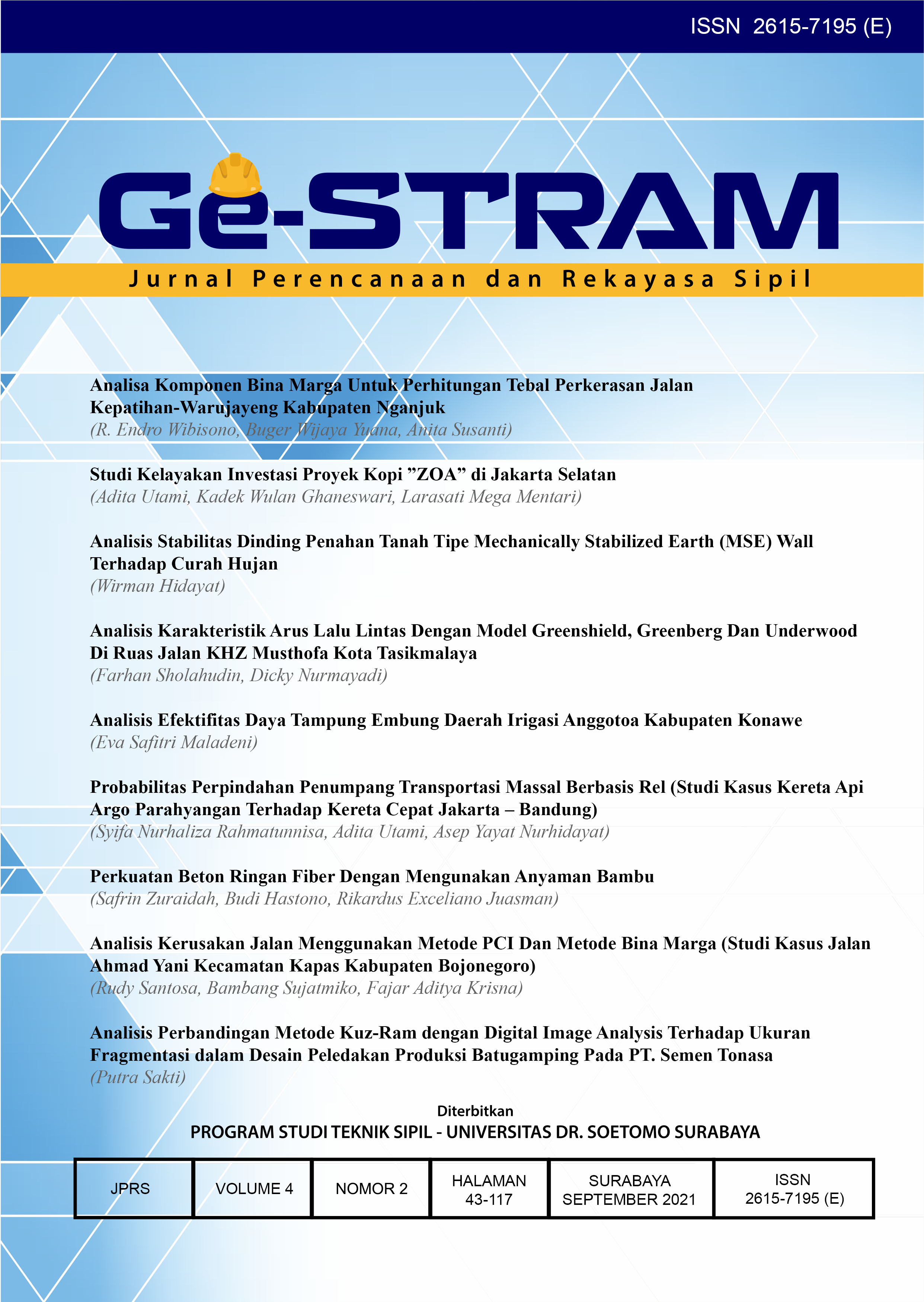Perkuatan Beton Ringan Fiber Dengan Mengunakan Anyaman Bambu
 Abstract views: 262
,
Abstract views: 262
,
 PDF downloads: 339
PDF downloads: 339
Abstract
Along with the rapid development of construction and infrastructure, so the need for concrete materials increases. In the field of engineering the development of concrete materials, from time to time, we always carry out innovations and research for construction materials. The price of steel reinforcement is increasingly expensive so it is very difficult for the middle to lower class to reach. The use of bamboo as a construction material has not proven its scientific quality and there is a lack of public understanding of the mechanical properties of bamboo. In order to provide an understanding and prove the quality of bamboo, this research was conducted by utilizing bamboo as reinforcement in lightweight fiber concrete. This research also uses strapping band type additives and the use of styrofoam as a substitute for coarse aggregate, the use of strapping band waste that is ± 70 mm long with a composition of 0%, 5%, 10%, and 15% of the weight of cement, styrofoam of 20% of the volume. test object. The method used is an experimental method that is carried out in a concrete laboratory.From the results of this study, the volume weight of concrete without woven bamboo was 16.67 kg / m³, decreased by (8.67%), and with woven bamboo was 15.22 kg / m³, compressive strength was 11.23 Mpa, decreased by (24.40%), and with bamboo plaited by 8.49 Mpa, split tensile strength of 1.65 Mpa, decreased by (3.03%), and with bamboo plaited by 1.6 Mpa, on 28 aged concrete days with a strapping band fiber content of 5%.It is recommended to use strapping band fibers of 5% of the weight of cement to obtain the optimum compressive strength and split tensile strength values, while the use of bamboo mat is not recommended for lightweight concrete.
References
ACISP-19, Cement and Concrete Terminology, American Concrete institute, 1985.
ACISP-19,â€Cement and Concrete Terminologyâ€,admixture
ASTMC 33-03. Standart Specification for Concrete Agregat, 2003.
ASTMC 494, Standart Specification For Chemical Admixture For Concrete, 1999.
Azwanda, dkk, 2017, “Pengaruh substitusi bahan anorganik plastik terhadap kuat tekan beton normalâ€.Jurnal Teknik Sipil Universitas Teuku Umar, Vol 3, No 4 (2017), pp. 52 – 63, Universitas Teuku Umar, Aceh Barat.
Fahrina R, Gunawan I, 2014. “Pemanfaatan bambu betung bangka sebagai penganti tulangan balok beton bertulanganâ€.Jurnal Forum Profesional Teknik Sipil, Vol 2, No 1 (2014), Universitas Bangka Belitung.
Mulyono, Tri, 2004. Teknologi Beton, Penerbit Andi, Yogyakarta.
Pathurahman, Jauhar Fajrin, 2003., “Aplikasi bambu pilinan sebagai tulangan balo betonâ€.Jurnal Teknik Sipil, Vol 5, No 1 (2003), ISSN 1410-9530, Universitas Mataram.
SNI 03-1971-1990. 1990. Metode Pengujian Kadar Air Agregat. Badan Standarisasi Nasional. Jakarta.
SNI 03-2491-2002, “Metode Pengujian Kuat Tarik Belah Betonâ€, Badan Standardisasi Nasional
SNI 15-2049-2004. 2004. Semen Portland. Badan Standarisasi Nasional. Jakarta.
Standart Nasional Indonesia (SNI) 03-1750-1990. Mutu dan cara uji Agregat Beton. Jakarta: Badan Standardisasi Nasional.
Zuraidah S, Jatmiko A. R., 2007, Pengaruh pengunaan limbah pecahan batu marmer sebagai alternatif penganti agregat kasar pada kekuatan beton., Jurnal Teknik Sipil, Vol 3, No 3 (2007), ISSN 1829-913x,Universitas Pembangunan Nasional “Veteran†Jawa timur.
Zuraidah S, Sujatmiko B, 2019. pemanfaatan limbah strapping band dan styrofoam dengan mengunakan pasir Mojokerto untuk bata ringanâ€.Jurnal Teknik Sipil, Vol 3, No 1 (2019),e-ISSN 2460-3430, Universitas DR Soetomo,Surabaya.
Copyright (c) 2021 Safrin Zuraidah, Budi Hastono, Rikardus Exceliano Juasman

This work is licensed under a Creative Commons Attribution-ShareAlike 4.0 International License.
Authors who publish with this journal agree to the following terms:
- Authors retain copyright and grant the journal right of first publication with the work simultaneously licensed under a Creative Commons Attribution-ShareAlike 4.0 International License that allows others to share the work with an acknowledgement of the work's authorship and initial publication in this journal.
- Authors are able to enter into separate, additional contractual arrangements for the non-exclusive distribution of the journal's published version of the work (e.g., post it to an institutional repository or publish it in a book), with an acknowledgement of its initial publication in this journal.
- Authors are permitted and encouraged to post their work online (e.g., in institutional repositories or on their website) prior to and during the submission process, as it can lead to productive exchanges, as well as earlier and greater citation of published work (See The Effect of Open Access).

This work is licensed under a Creative Commons Attribution-ShareAlike 4.0 International License.















